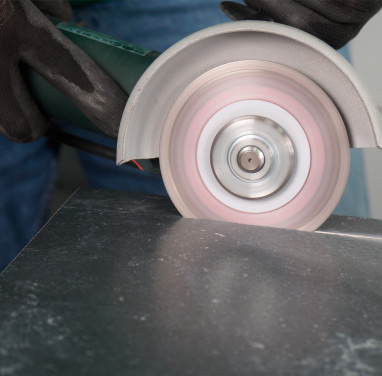Clean edge without compromise: porcelain stoneware cutting technique with a 125 mm angle grinder

Introduction
Cutting porcelain stoneware is one of the most complex operations in finishing work. The material is characterized by high strength, brittleness, and sensitivity to vibration. To achieve a clean and even edge without chipping, it is essential to select the right equipment, diamond blade, and follow a specific technique.
In this article, we will look at how to properly cut porcelain stoneware with a 125 mm angle grinder (AG) to minimize chipping. After all, in today’s world, a tiler’s skill is defined by their ability to perform a clean, high-quality cut.
What is porcelain stoneware and what types exist
Porcelain stoneware is a man-made finishing material produced by pressing and firing a fine-grained mix of clay, quartz sand, feldspar, and mineral pigments. It combines the strength of natural stone with the aesthetics of ceramic tile.
Key properties of porcelain stoneware:
-
High density and water absorption < 0.5% – suitable for indoor and outdoor use, including frost-prone areas
-
Mohs hardness: 7–8 – virtually scratch-resistant and wear-resistant
-
Abrasion resistance – in high-traffic zones (malls, train stations), only porcelain stoneware is used
-
Fire resistance and chemical inertness – does not burn, does not react with acids or alkalis
Types of porcelain stoneware by processing and use:
-
Matte (natural) surface – no additional treatment, natural roughness
-
Polished – ground after firing, mirror-like gloss but slippery
-
Lappato (semi-polished) – combines matte and glossy textures
-
Glazed – decorative coating enhances design variety, but the top layer is fragile
-
Technical (industrial) – undecorated, used in production facilities
Sizes and thickness:
-
Sizes:
-
Small format: under 300×300 mm
-
Standard: 300×300, 600×600, 600×1200 mm
-
Large format (slab): from 800×1600 to 1200×2780 mm
-
-
Thickness:
-
3–6 mm – ultra-thin format for façades, furniture, walls
-
8–12 mm – universal for floors and walls
-
20–30 mm – outdoor paving, terraces, stairs, façades without substructures
-
What kind of angle grinder is suitable for cutting porcelain stoneware
To achieve high-quality results, the angle grinder (AG) must meet the following parameters:
-
Disc diameter: 125 mm
-
Power: from 900 to 1400 W
-
Speed: 11,000–12,000 RPM
-
Speed control: recommended
-
Soft start: reduces impact load
-
Anti-vibration handles: improve precision and comfort
Most professionals choose the lightest possible AGs to reduce strain on hands and wrists during prolonged work.
Which blade is suitable for clean cutting of porcelain stoneware
A properly chosen AG is only part of success. The key role belongs to the diamond blade. For precise cutting, it is recommended to use:
-
Continuous rim diamond blades with fine-grit coating
-
Diamond layer thickness: 0.6–1.2 mm
-
Laser cuts or cooling holes
-
Self-sharpening bond with fine diamond grain
-
Rigid and thin core with minimal vibration
-
Additional flange – protects the core from deformation
The more of these features a blade has, the better the result. Below are specific examples.
Review of Distar blades for porcelain stoneware
Distar offers a professional line of diamond blades for tile and porcelain. Here are the five most popular models:
-
Distar Scalpel 1A1R 100
Thickness: 0.9 mm
For precision cutting, mosaics, inserts
Ultra-thin cut, high accuracy
Compatible with 115/125 mm AG, suitable for dry and wet cutting -
Distar Elegant 1A1R 100
Thickness: 1.2 mm
For glazed tile and porcelain
Ideal for chip-free finishing cuts
Stable operation without vibration -
Distar Decor Slim 1A1R 125
Thickness: 1.2 mm
Universal blade for wall and floor tiles
High cutting speed, clean edge
Resistant to microvibration -
Distar Perfect 1A1R 115
Clean-cut blade for medium-thickness tiles
Reliable choice for daily use
Optimal balance between durability and quality -
Distar Shine 1A1R 125
Thickness: 0.6 mm
Designed for glossy tiles
Ultra-thin cut without damaging the surface
Works only with water, leaves a mirror finish
Comparison table
| Model | Diameter | Layer thickness | Application | Advantages |
|---|---|---|---|---|
| Scalpel | 100 mm | 0.9 mm | Precision cutting | Ultra-thin cut, mosaics, decorative inserts |
| Elegant | 100 mm | 1.2 mm | Glazed tile, rectified | Chip-free, high-speed |
| Decor Slim | 115–125 mm | 1.2 mm | Universal | Balance between speed and edge quality |
| Perfect | 115–125 mm | 1.2 mm | Domestic tile | Clean edge in dry mode, good performance |
| Shine | 100–125 mm | 0.6 mm | Glossy tile, polishing | Minimal chipping, mirror edge, water operation |
Pro tips for clean cutting
-
Fix the tile – place on a rubber or plywood base, secure with clamps
-
Guide rail – use a profile or metal straightedge with clamps
-
Two-step cutting – first shallow (1/3), then full depth
-
Masking tape – apply along the cut to protect the glaze
-
Cooling – moisten the cut zone or use dust extraction
-
Don't press on the blade – let the diamonds do the work
-
Edge finishing – use diamond sponges or polishing pads for final touches
Conclusion
Chip-free cutting of porcelain stoneware is not magic – it’s the result of proper technique, experience, and quality tools. A 125 mm AG with a good diamond blade, soft start, and stable handling, combined with proven Distar models (Scalpel, Elegant, Decor Slim, etc.) will help you achieve results worthy of a professional.
By following the described tips and techniques, you’ll avoid chipping and achieve a clean, aesthetic cut.







